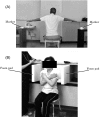A modified seated side tapping test in which the arms are crossed also reflects gait function in community-dwelling elderly
- PMID: 28931996
- PMCID: PMC5599829
- DOI: 10.1589/jpts.29.1598
A modified seated side tapping test in which the arms are crossed also reflects gait function in community-dwelling elderly
Abstract
[Purpose] Seated side tapping test (SST) performance is associated with mobility impairment in the elderly. Although this test was developed to assess trunk function, interpretation of its results may be confounded by the upper-limb movements in its protocol. Here, this study aimed to validate the association between trunk function and gait function by means of the Arms Crossed SST (AC-SST), a modified version of the SST in which the arms are crossed over the chest, to exclude the effects of the upper limbs. [Subjects and Methods] A total of 116 community-dwelling elderly people were enrolled in the study (mean age: 75.1 ± 5.5 yrs). Measurement categories were gait function (gait speed and TUG), lower extremity strength (knee extension and flexion strength), trunk muscle endurance (trunk extension and flexion endurance), and trunk function (SST and AC-SST). [Results] AC-SST performance significantly correlated with gait function items, as did SST performance. Moreover, AC-SST was one of the significant predictor variables of gait function selected in stepwise multiple regressions. [Conclusion] Gait function associated with performance on the AC-SST, a test of trunk function in which the effects of upper limb function were excluded, reinforcing the importance of trunk function to elderly mobility.
Keywords: Gait; Seated side tapping test; Trunk function.
Figures
Similar articles
-
Quickness of trunk movements in a seated position, regardless of the direction, is more important to determine the mobility in the elderly than the range of the trunk movement.Arch Gerontol Geriatr. 2014 Jul-Aug;59(1):107-12. doi: 10.1016/j.archger.2014.02.001. Epub 2014 Feb 8. Arch Gerontol Geriatr. 2014. PMID: 24598199
-
An easy and safe training method for trunk function improves mobility in total knee arthroplasty patients: A quasi-randomized controlled trial.PLoS One. 2018 Oct 4;13(10):e0204884. doi: 10.1371/journal.pone.0204884. eCollection 2018. PLoS One. 2018. PMID: 30286130 Free PMC article. Clinical Trial.
-
[Lateral trunk control in a sitting test is associated with mobility and Instrumental Activities of Daily Living among community-dwelling elderly people].Nihon Ronen Igakkai Zasshi. 2012;49(4):449-56. doi: 10.3143/geriatrics.49.449. Nihon Ronen Igakkai Zasshi. 2012. PMID: 23269024 Japanese.
-
Quick lateral movements of the trunk in a seated position reflect mobility and activities of daily living (ADL) function in frail elderly individuals.Arch Gerontol Geriatr. 2013 May-Jun;56(3):482-6. doi: 10.1016/j.archger.2012.12.002. Epub 2012 Dec 25. Arch Gerontol Geriatr. 2013. PMID: 23270712
-
Contributions of Ankle, Knee, Hip, and Trunk Muscle Function to Gait Performance in People With Multiple Sclerosis: A Cross-Sectional Analysis.Phys Ther. 2018 Jul 1;98(7):595-604. doi: 10.1093/ptj/pzy048. Phys Ther. 2018. PMID: 29660080
Cited by
-
Examination of the Impact of Strength and Velocity of the Knee and Ankle on Gait Speed in Community-Dwelling Older Adults.Healthcare (Basel). 2022 Oct 20;10(10):2093. doi: 10.3390/healthcare10102093. Healthcare (Basel). 2022. PMID: 36292540 Free PMC article.
References
-
- Montero-Odasso M, Schapira M, Soriano ER, et al. : Gait velocity as a single predictor of adverse events in healthy seniors aged 75 years and older. J Gerontol A Biol Sci Med Sci, 2005, 60: 1304–1309. - PubMed
-
- Cesari M, Kritchevsky SB, Penninx BW, et al. : Prognostic value of usual gait speed in well-functioning older people—results from the Health, Aging and Body Composition Study. J Am Geriatr Soc, 2005, 53: 1675–1680. - PubMed
-
- van Hedel HJ, Wirz M, Dietz V: Assessing walking ability in subjects with spinal cord injury: validity and reliability of 3 walking tests. Arch Phys Med Rehabil, 2005, 86: 190–196. - PubMed
LinkOut - more resources
Full Text Sources
Other Literature Sources

